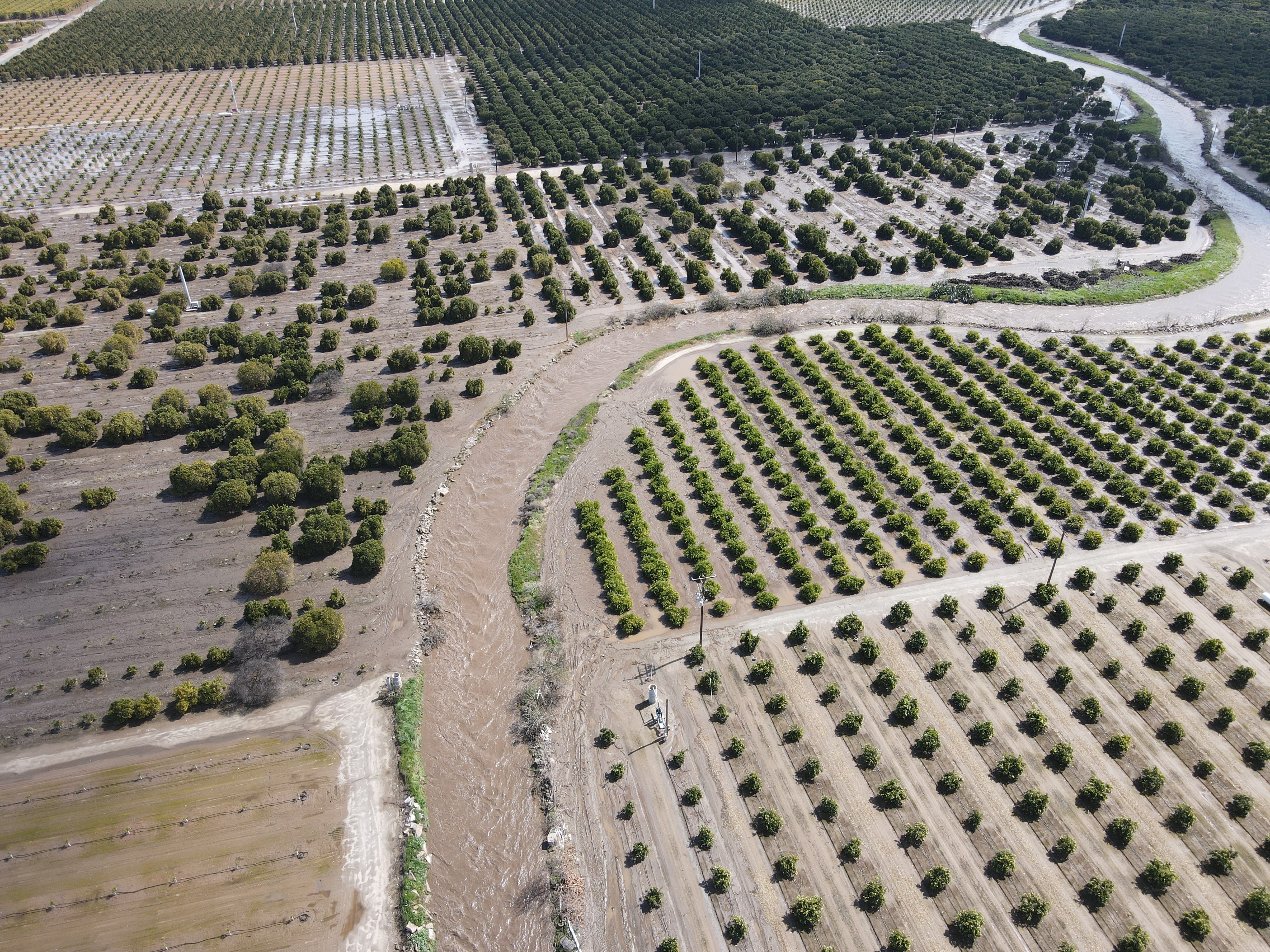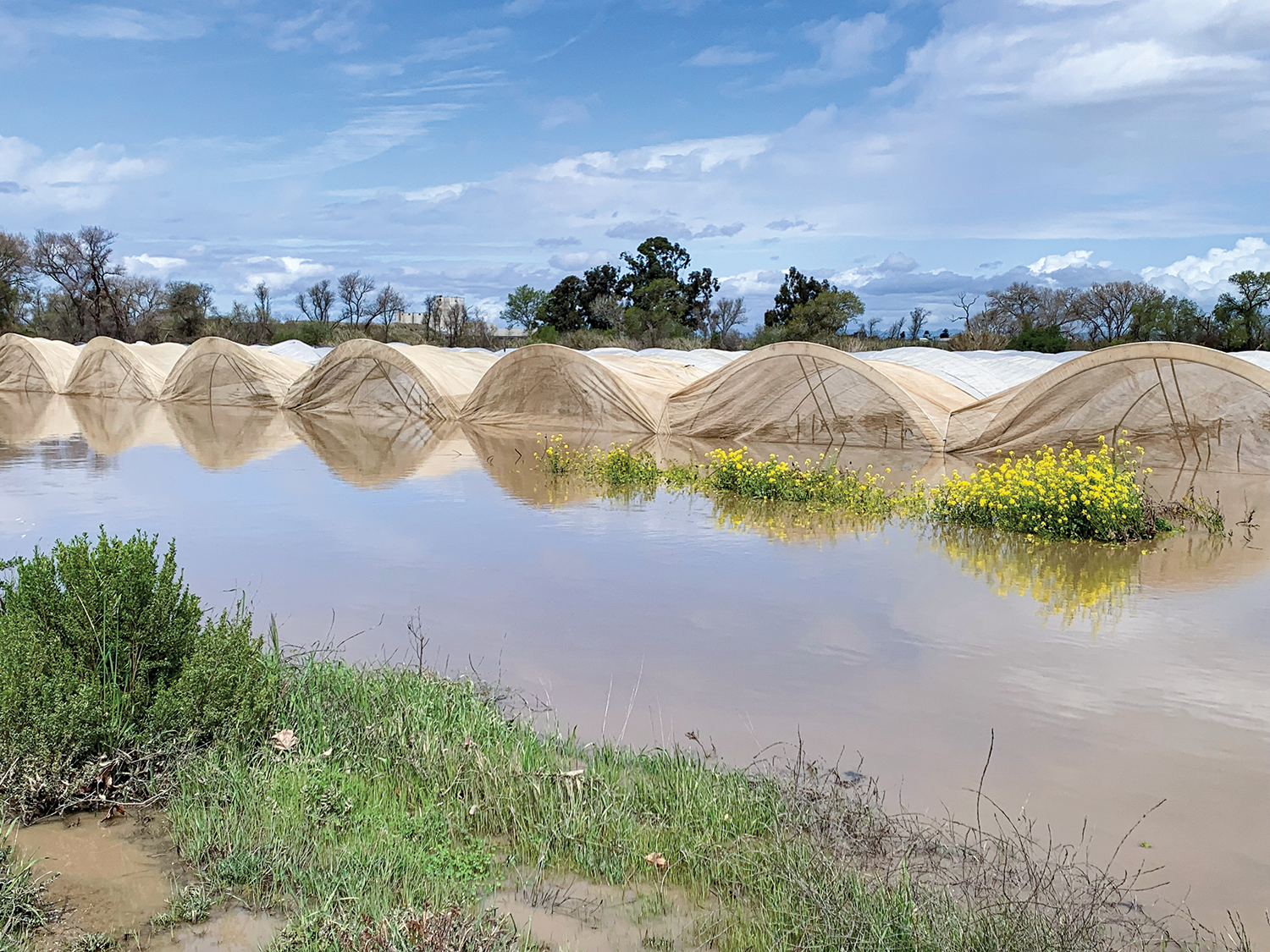Farms statewide hit by storms and floods

Relentless storms brought destructive flooding to many California communities.
Photo by Mark Hull

Relentless storms brought destructive flooding to many California communities, such as in Tulare County near Exeter, where floodwater in citrus groves brought several feet of mud and debris. Farmers say recovery will be costly and it will take months before they can return to farming.

By Christine Souza and Ching Lee
Warm atmospheric river storms wreaked havoc on California last week, causing widespread flooding from rain and snowmelt, which overfilled rivers and creeks, displaced residents, washed out roads and damaged agriculture.
In Tulare County, flooding forced farmers to evacuate cows and the current carried silt and debris into citrus groves. In Monterey County, water flooded leafy greens and berries. The storm impacted livestock and feed crops in northern California counties, such as Humboldt.
Farmers in Tulare County said they worked in shifts to address flooding in communities downstream of the Tule River, which feeds into Lake Success near Porterville, and downstream of the Kaweah River, which feeds into Lake Kaweah near Lemon Cove.
Zack Stuller, a Tulare County farm manager, said responding to flooding has been a countywide effort to plug holes in streambanks, remove debris and monitor for any emerging problems.
“We rounded up as many dump trucks as we could, and as many guys with dozers and excavators, and we worked 24 hours straight,” Stuller said. “We got permission and put Yokohl Creek back together ourselves.”
Tulare County dairy and citrus farmer Tom Barcellos of Tipton, who runs an excavation business, said he had three excavators and a backhoe operating nonstop. The flooding “is in excess of what all of these rivers can handle,” he said.
“The challenge is on the creeks that have no control structure. They’re going to run until they slow down and that means that they’re going to run for a while, and wherever they’re broke out, good luck, because there’s no stopping it,” Barcellos said. “It’s not just here, it’s Fresno County, Madera County, Kern County—there’s just water everywhere.”
For at-capacity reservoirs, facility managers announced plans to release water through dam spillways to make room for water from the next storm.
Cows were evacuated from several dairies impacted by floodwater from the Tule River and were moved to another dairy facility. Moving the dairy cows, farmers said, brings its own set of challenges, such as having to break cows into a new environment and finding feed to replace what was damaged.
Meanwhile, citrus groves have an “extensive amount of debris,” Stuller said.
“At one ranch there was seven propane tanks—I don’t know where they came from—and porta-potties, logs and mud,” he said. “We have a lot of local flooding, just massive damage to orange groves with 2 feet to 5 feet of silt.”
Barcellos said, “I saw drip lines strung out across the road because of the force of the water flowing through the orchard. It’s going to be wet, muddy and full of silt for a long time.”
Floodwaters are filled with “massive trees,” Barcellos said. Water managers at Lake Success were trying to keep debris from hitting the spillway and “building its own beaver dam that just floods everything even that much worse.”
Tulare County Farm Bureau organized a list of volunteers and services to help in the effort. Tulare County asks that dairies and farms report evaculations to the county’s flood hotline at 559-802-9791.
In Monterey County, there was significant flooding along the Salinas River and two levee breaks along the Pajaro River. Residents of Pajaro, including farmworkers, were evacuated. Gov. Gavin Newsom visited Pajaro last week to view the damage and meet with government leaders and first responders.
Monterey County Farm Bureau Executive Director Norm Groot said he expects agricultural damage to exceed the $336 million caused by storms that hit the region in January, affecting 15,705 acres.
“There will be more crop losses as areas that have not experienced flooding now are experiencing it for the first time,” Groot said.
With food safety the highest priority, Groot said storm-flooded fields must undergo a testing protocol to return to production. The protocol, established by the California Leafy Greens Marketing Agreement, is needed to determine whether pathogens are in the fields. The process may take 60 days after waters recede.
“With fields being so saturated and inaccessible,” Groot said, “planting schedules set for March will probably be delayed.”
The California Strawberry Commission said, “Our farming communities will face a massive cleanup before they can even begin the process of preparing the fields again and starting over.”
Despite the challenges, the commission said there will be increased shipments of strawberries from Oxnard and Santa Maria to keep up with demand.
The deluge of storms that dumped several feet of snow in mountain ranges left grazing cattle stranded and ranchers unable to access their animals due to impassable roads, downed trees and harsh conditions. Humboldt County officials said they had received multiple reports of cattle starving and dying, with some 30 ranchers in the region reaching out for help.
Agencies, including the Sheriff’s Office of Emergency Services, the state Governor’s Office of Emergency Services, CalFire and the U.S. Coast Guard, worked to deliver rancher-provided bales of hay via helicopter to the hungry cattle. Dubbed “Operation Hay Drop,” the effort started March 5 and assisted more than 2,000 cattle in Humboldt, Mendocino and Trinity counties.
Todd Fulton, who runs a cow-calf operation in Humboldt County, said he received three air drops for his cattle in Kneeland. While the hay didn’t help his cattle gain weight, he said, it kept them alive. With the warmer temperatures and snowmelt last week, he said most of his cattle were back on the home range, and the calves “look pretty good,” though he had not yet done a full headcount.
“I don’t know that anybody fell onto any catastrophic losses, but I’m sure there’s going to be losses reported,” Fulton said. Some operations won’t be able to fully assess their numbers until later in the year when the snow thaws, he added.
In Plumas and Sierra counties, rancher Dave Roberti said cold temperatures and lack of sunshine have not produced enough grasses for his grazing cattle, which means he’s been “feeding expensive hay all year long.”
He said ranchers in the region typically don’t store or buy any hay because they ship cattle from pasture to pasture. When their pastures are short of feed, “going out finding hay is tough to do, this year especially.” His cattle have lost weight, as “there’s just not enough feed to sustain them.”
Roberti said he’s also worried about the impact of flooding on alfalfa fields, which can be lost if left in standing water.
Jimmy Hook, president of the California Agricultural Commissioners and Sealers Association, said agricultural commissioners are collecting damage information but he expects delays due to the wet conditions. “This would be a good scenario for a state (disaster) declaration and it sounds like information collection has started to assess that avenue,” said Hook, who is the agricultural commissioner in Kings County.
At the governor’s request, President Joe Biden issued a presidential emergency declaration last week, authorizing federal assistance to support state and local storm response efforts. With storms forecast to continue this week, the state of emergency was declared in 43 counties.
(Christine Souza and Ching Lee are assistant editors of Ag Alert. They may be contacted at csouza@cfbf.com and clee@cfbf.com.)




